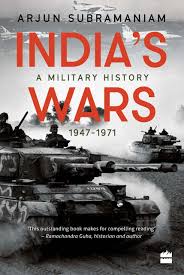📕 Book Name: India’s Wars: A Military History, 1947–1971
🖋️ Author: Air Vice Marshal Arjun Subramaniam (Retd.)
📚 Category: India-Pak Wars
📅 Published: 2016
🔥 Summary
“India’s Wars” chronicles the evolution of the Indian military from 1947 to 1971, covering key conflicts like the 1947–48 Kashmir War, 1962 Sino-Indian War, 1965 and 1971 wars with Pakistan, as well as internal operations like Hyderabad and Goa. The author, a senior IAF officer, blends operational detail with strategic insight, presenting a holistic narrative of India’s war-making process.
🧠 Key Takeaways
-
Clear explanation of jointness between the Army, Navy, and Air Force.
-
Real accounts of battlefield decisions at all levels — from Generals to unit commanders.
-
Strategic lessons from failures (like 1962) and strengths (like 1971 Eastern Theatre).
-
Insight into the political-military interface during wartime.
-
Rare first-person interviews included.
🎯 Relevance for Defence Aspirants
-
-
Enhances understanding of war strategy and doctrine.
-
Gives an insider’s view of leadership, operations, and logistics.
-
Builds historical context that helps in SSB interviews, CDS/IMA prep, and military writing.
-
India’s Wars: A Military History, 1947–1971 by Air Vice Marshal Arjun Subramaniam (Retd)
—
1. Introduction
Title: India’s Wars: A Military History, 1947–1971
Author: AVM Arjun Subramaniam (Retd)
Focus: A comprehensive account of India’s military history from independence to the 1971 Indo-Pak War.
Objective: To present an integrated view of India’s military operations, combining land, air, and naval campaigns.
—
2. Overview of the Book
-Covers major wars: 1947–48 Kashmir War, 1962 Sino-Indian War, 1965 and 1971 Indo-Pak Wars.
-Includes counterinsurgency operations and military diplomacy.
-Based on military archives, oral histories, and secondary sources.
3. Strengths of the Book
Tri-service Perspective: Balanced analysis of Army, Navy, and Air Force operations.
Operational Insight: Highlights planning, execution, and leadership challenges.
Accessible Writing: Suitable for both scholars and general readers.
—
4. About the Author
Arjun Subramaniam: Retired Air Vice Marshal, academic, and military historian.
Held key positions in the IAF and is known for scholarly contributions on warfare and strategy.
—
5. Background
Written in context of the need for indigenous military historiography.
Bridges the gap between military professionals and civilians in understanding India’s security challenges.
—
6. Key Lessons
-Importance of joint operations and inter-service coordination.
-Value of political-military synergy in achieving strategic objectives.
-Need for modernization and doctrinal clarity.
—
7. Relevance Today
Offers valuable insights for current military reforms and doctrine development.
Enhances strategic awareness in a volatile geopolitical environment.
Useful for professional military education and policy analysis.
—
8. Highlights
Key Events Covered:
1947–48 Kashmir conflict
1962 war debacle and lessons
1965 war stalemate and Air Force’s role
1971 Bangladesh Liberation War
Military Diplomacy: India’s evolving role in global strategic affairs.
—
9. Tactics and Strategies
Mountain Warfare: 1962 operations and lack of preparedness.
Armoured and Air Operations: 1965 & 1971 saw coordinated use of tanks and air power.
Heliborne and Amphibious Tactics: Effective use during 1971 Eastern sector.
—
10. Lessons Learned
Training & Logistics: Importance of pre-war preparation.
Civil-Military Relations: Need for better institutional integration.
Doctrine & Innovation: Success depends on clear objectives and adaptive planning.
—
11. Criticisms
Limited Dissenting Views: Less critical of leadership failures.
Institutional Bias: Leans slightly towards glorification of services.
Dense Chapters: Heavy reading for those unfamiliar with military terminology.
—
12. Conclusion
India’s Wars is a landmark contribution to Indian military historiography. Arjun Subramaniam successfully blends operational detail with strategic analysis, making it essential reading for military professionals, scholars, and policy-makers. It sets a strong precedent for future documentation of India’s defence history post-1971.
⭐ Verdict
A must-read for any serious defence aspirant or military history enthusiast. It not only narrates the events but teaches how wars are actually fought, coordinated, and won.
Rating: ⭐⭐⭐⭐⭐ (5/5)